Abstract
Ultrasound is a powerful and versatile technology that has been applied extensively in medicine and scientific research. The development of miniature underwater robots focuses on achieving specific tasks, such as surveys and inspections in confined spaces. However, traditional sonar has limited use in micro underwater robots due to its large size and heavy power demands. Conversely, capacitive micromechanical ultrasonic transducers (CMUTs) offer various advantages, including a wide bandwidth, compact size, and integration feasibility. These attributes make CMUTs a candidate for obstacle avoidance in micro underwater robots. Hence, a novel CMUT structure using Si-Si bonding is proposed. In this design, a membrane isolation layer replaces the cavity bottom isolation layer, simplifying the process and improving bond reliability. A finite element model of the CMUT was constructed in COMSOL and numerically assessed for the CMUT’s operating frequency, collapse voltage, and submerged depth. The CMUT, manufactured using micro-electro-mechanical system (MEMS) technology, undergoes waterproofing with PDMS—A material with similar acoustic impedance to water and corrosion resistance. Underwater tests reveal the CMUT’s resonant frequency in water as approximately 2 MHz, with a −3 dB bandwidth of 108.7%, a transmit/receive beam width of 7.3°, and a standard deviation of measured distance from the true distance of less than 0.05. These outcomes suggest that CMUTs hold promise in obstacle avoidance applications for fish-shaped underwater robots.
1. Introduction
Underwater robots play a crucial role in various fields, including oceanic research, underwater resource extraction, environmental conservation, and safety monitoring. These robots possess the ability to sense their surroundings, navigate independently, and circumnavigate obstacles. Effective obstacle avoidance is necessary for successful mission execution. B. Braginsky and H. Guterman have developed a two-layer obstacle avoidance algorithm (OAA) for autonomous underwater vehicles (AUVs). The algorithm features pre-planning and horizontal plane obstacle avoidance response methods [1]. Changjian Lin et al. introduced a recurrent neural network with a convolutional function for real-time obstruction prevention planning for unmanned underwater vehicles (UUVs), albeit one solely verified through simulated data [2]. Various sensor-based approaches are employed in underwater robotics for obstacle detection and navigation in their immediate environment. Commonly used techniques for obstacle avoidance include sonar [3,4], cameras [5,6], or LiDAR [7,8,9]. Current underwater imaging sonar technologies such as the Farsounder-1000 (Farsounder, Warwick, RI, USA), EchoPilot FLS 3D (Daniamant, Slangerup, Denmark), and Echoscope4G (Coda Octopus, Edinburgh, UK) are used for obstacle avoidance. They share common features, such as significant dimensions, substantial weight, elevated power consumption, and a steep price tag. These factors hinder their ability to navigate through confined underwater environments, like narrow crevices and small pipes, to avoid obstacles.
Advances in micro-electro-mechanical systems (MEMS) technology have further reduced the size of chips. Currently, the CMUT (capacitive micromachined ultrasonic transducer) and PMUT (piezoelectric micromachined ultrasonic transducer) have emerged as significant ultrasonic transducers owing to their compact size, low energy consumption, and compatibility with circuitry. These benefits lead to the continuous miniaturization of underwater micro-robots. Most of the following studies utilized imaging techniques to detect and avoid obstacles. O. J. Adelegan et al. fabricated an air-coupled CMUT with a ring and spiral cavity structure to achieve the imaging of plastic letters [10]. Wang, Z. et al. manufactured a 2D CMUT linear array in silicone oil for imaging obstacles [11]. Tong Z. et al. fabricated flexible PMUTs to verify the possibility of using flexible ultrasound sensors to sense obstacles in a bent state [12]. S. Sadeghpour et al. designed and fabricated three different architectures of PMUTs that are applicable for underwater imaging [13]. G.-H. Feng et al. introduced a new technique to fabricate PMUTs on thin metal foils, which was applied to ranging radar experiments and achieved a resolution of about 50 µm at a distance of 15 cm [14]. However, the signal acquisition, processing, and imaging systems necessary for underwater imaging can be demanding, potentially increasing the size of the robot. A single CMUT can achieve sonar-based obstacle avoidance. CMUT technology has found practical applications in the field of medical ultrasound imaging [15]. CMUT has evolved considerably since the 1980s, when Prof. Butrus Khuri-Yakub’s team proposed the concept of CMUT. In 1994, Haller, M.I. and Khuri-Yakub, B.T. introduced the CMUT concept and fabricated CMUTs that could be used in the air via a sacrificial layer release process [16]. In 1996, Soh, H.T. et al. fabricated submerged CMUTs by vacuum-sealing a cavity to enable the transmission of ultrasound underwater [17]. In 2002, Huang, Y. et al. designed and fabricated 10 kHz- to 150 kHz-frequency CMUTs for sonar applications using wafer bonding [18]. In 2011, Park, K.K. et al. designed and fabricated CMUTs with a 40 nm gap height to suppress the gap height and reduce the parasitic capacitance, using a Locos-based process and direct wafer bonding technology [19]. With the development of MEMS technology, Yamaner, F.Y. et al. used anodic bonding to fabricate transparent CMUTs on glass substrates [20]. Moini A. et al. fabricated 2D arrays for volumetric imaging [21]. The flexibility of flexible devices led to the use of flexible materials instead of silicon as substrates and su−8 as sidewalls for manufacturing flexible CMUTs, as demonstrated by Pang, D.-C. et al. [22]. Compared to conventional piezoelectric ultrasonic transducers, CMUTs offer several intrinsic advantages, including high sensitivity, wide bandwidth, highly accurate batch manufacturing, integration with CMOS, good acoustic impedance matching with water, and high electromechanical conversion efficiency [23,24]. The rapid evolution of CMUTs has enabled their application in various fields, primarily in medical imaging and therapy, biochemical and physical sensors, and airborne applications. Danhua, Z. et al. used a 15 MHz, 256-element linear array ultrasound probe for imaging using a CMUT made by Kolo Medical Inc. in the USA [25]. Rezvanitabar, A. et al. proposed an active impedance-matching scheme to optimize the electrical power transfer and acoustic reflectivity of a CMUT to improve imaging quality [26]. Yoon, H.S. et al. described the fabrication of a 32 × 32-element CMUT array for HIFU applications. Focused at 8 mm in depth, with a 5 MHz excitation frequency, the output pressure reached 8.5 MPa [27]. A similar CMUT-based IDT was developed by Pelenis, D. et al. for the detection of bovine serum albumin (BSA) [28]. Choi, W.Y. et al. reported the use of a CMUT for imaging fingerprint models with the help of direct touch and waveguide modeling [29]. Anzinger, S. et al. introduced an innovative airborne CMUT designed for airborne ranging using the dual backplane (DBP) technique, allowing a single CMUT to accurately detect the distance to an acoustically reflective metal plate [30]. However, there are limited studies on the application of CMUTs in underwater micro-robots.
Therefore, a novel CMUT structure based on silicon-silicon bonding technology is proposed for the obstacle avoidance application of underwater miniature fish-shaped robots. This design uses the thickness of the silicon oxide to determine the height of the cavity and employs silicon oxide on the membrane, instead of using it as an insulating layer at the bottom of the cavity. This results in a more consistent cavity structure, simplifying the fabrication process and improving bonding stability. The CMUTs are arranged around the fish-shaped robot to achieve underwater obstacle avoidance. Figure 1 illustrates the fish-shaped underwater obstacle avoidance robot. Additionally, a finite element model is established in this paper to simulate and calculate the CMUT’s performance. The CMUT’s performance is tested underwater and the feasibility of underwater obstacle avoidance is verified. The experimental results demonstrate that the CMUTs fabricated in this study meet the requirements for underwater ultrasonic obstacle avoidance applications and provide a reference for subsequent related research.

Figure 1.
The effect picture of the fish-shaped underwater obstacle avoidance robot (Red dots represent CMUTs).
This study details the design and preparation of a novel capacitive micromechanical ultrasonic transducer, exploring its potential application for obstacle avoidance in underwater micro-robots. Section 2 elucidates the working principle of the CMUT, while Section 3 and Section 4 describe the simulation design model of the CMUT and the fabrication process. Section 5 outlines the testing of the encapsulated capacitive microsensor through immersion in water to validate its feasibility. In conclusion, we summarize our findings and propose future research directions.
2. Working Principle
The CMUT, a micromechanical ultrasonic sensor, transmits and receives ultrasonic signals by applying voltage excitation between its upper and lower electrodes. It can be described and analyzed as either a parallel-plate capacitor with a fixed lower electrode and a movable upper electrode or as a double-ended network equivalent circuit in the electrical–mechanical domain [31]. Comprising multiple cells connected in parallel, it forms a CMUT element and operates in two modes. In the transmitting mode, a DC bias voltage (Vdc) is applied between the electrodes, inducing the initial deformation of the membrane. An AC voltage signal (Vac) excites the membrane, causing vibration and the generation of ultrasonic waves. When used as a receiver, the CMUT requires the same Vdc to pre-deform the membrane. Sound waves propagate to the surface of the vibrating film, causing vibration and generating an electrical signal that varies with capacitance.
When analyzing the static characteristics of the CMUT using the minimum constituent unit cell, these can be approximated with a spring-mass-damping model, employing the principles of parallel plate mechanics [32], as illustrated in Figure 2. This model encompasses the spring constant (kp), mass (mp), and damping constant (rp). The dampers (rm) and mass (mm) represent the acoustic impedance of the medium. The resonant frequency of the CMUT can, thus, be determined [33]:
where ε0 represents the vacuum dielectric constant, εr represents the relative permittivity of the diaphragm and insulation (assumed to be the same, here), and A represents the electrode area. Vdc is the DC bias voltage applied between the electrodes, while geff and xdc represent the effective gap height at zero bias and the amount of gap variation at bias voltage Vdc.
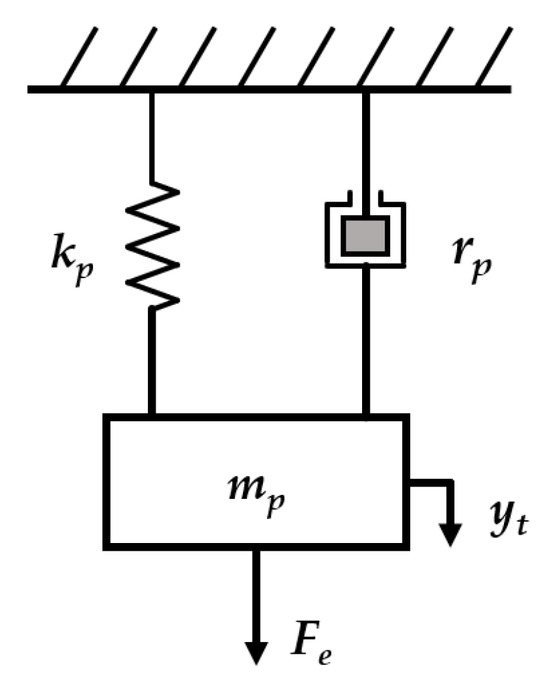
Figure 2.
Spring-mass-damping model.
2.1. Parallel Plate Capacitor Model
The formula for calculating the capacitance of a parallel plate capacitor is:
where g represents the initial cavity height and Δg denotes the membrane displacement under Vdc. Neglecting the external forces, the forces acting on the vibrating film consist of the electrostatic force (Fe) and the elastic recovery force (Fs).
Here, K is the spring constant.
2.2. Equivalent Circuit Model
The CMUT can be considered as a two-port network consisting of electrical and mechanical domains [34,35], as depicted in Figure 3. The small-signal characteristics of the CMUT can be assessed to determine its transmit–receive (RX) sensitivity.

Figure 3.
CMUT electromechanical double−ended network diagram.
The maximum CMUT output pressure is achieved at the resonant frequency, and the output sound pressure per volt can be ascertained as follows [33]:
where n is the electric field and transformer ratio. Meanwhile, the CMUT’s maximum received sensitivity can be expressed as follows [36]:
where Pin represents the input pressure, Iout represents the output current, E0 is the electric field strength, and C0 represents the clamping capacitance of the CMUT at bias voltage Vdc, respectively.
3. Design and Simulation
Simulation design plays a crucial role in CMUT fabrication. It provides several benefits, including optimizing design solutions, predicting performance, and reducing experimental costs and time, as well as troubleshooting issues during preparation and application. It is an efficient, cost-effective, and reliable method that supports the manufacturing and application of CMUTs.
Figure 4 illustrates the structure of the CMUT. It involves a fixed bottom electrode located on a low-resistivity silicon substrate, while the top electrode is deposited on a suspended vibrating membrane. The resonant frequency of the CMUT is determined by the material properties, size, and shape of the vibrating membrane. Typically, CMUTs adopt edge-fixed parallel plate capacitor structures, with a cavity 0.3 μm in height between the top and bottom electrodes. The electrodes are usually made of chromium–gold. A thin layer of chromium serves as an adhesion layer to enhance the stability. The vibrating film is fabricated using the device layer of the silicon-on-insulator (SOI), and the height of the cavity is directly determined by the thickness of the oxide layer. The sensitivity of the CMUT is greatly influenced by the precision of micromachining and the Vdc. However, this sensitivity and these parameters have trade-offs, as the smaller capacitor gap restricts top electrode displacement, limiting the maximum sound pressure generated.
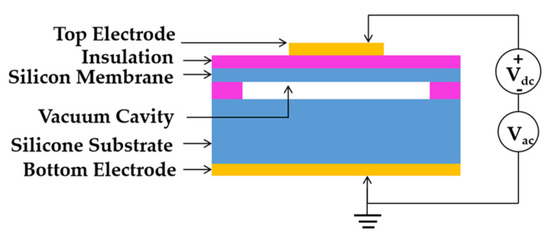
Figure 4.
Schematic diagram of the CMUT structure in cross−section.
In practical applications, the characteristics of CMUT cells are influenced by various factors, including the size and shape of the cell, the thickness and material of the upper electrode, the encapsulation structure, and the surrounding medium. Therefore, it is imperative to scrutinize and enhance the CMUT cell’s static and dynamic features through numerical simulations, finite element analyses, and experiments to attain optimal performance for specific applications.
The performance of the CMUT is simulated and calculated using COMSOL Multiphysics 6.1 and MATLAB 2019b [35,37]. COMSOL is a professional multi-physics field simulation software developer, providing general-purpose simulation software and simulation app tools based on advanced numerical methods, supporting single-field and multi-physics field coupling simulations. The dimensions of the structure can be found in Table 1. The CMUT structure’s construction utilizes the software’s solid mechanics module, while the electrostatic driving force and alternating voltage applied to the CMUT are simulated using the electrostatics module. Moreover, the pressure acoustics frequency domain interface is used to simulate the CMUT’s operational surroundings in diverse media, including water.

Table 1.
CMUT structural parameters.
When the CMUT is immersed in water, the resonant frequency is determined through multi-physics field coupling calculations. Initially, the membrane vibration is generated by applying DC and an AC voltage to the top and bottom electrodes. Subsequently, the sensor’s resonant frequency is obtained by analyzing the harmonic response at the peak frequency of the membrane vibration displacement, as depicted in Figure 5a. It should be noted that the magnitude of the DC bias voltage affects the sensor’s resonant frequency. Figure 5b shows a shift towards lower frequencies with increasing DC bias. This phenomenon has been explained and confirmed by F.D. Bannon III et al., using resonators to soften the spring [38].
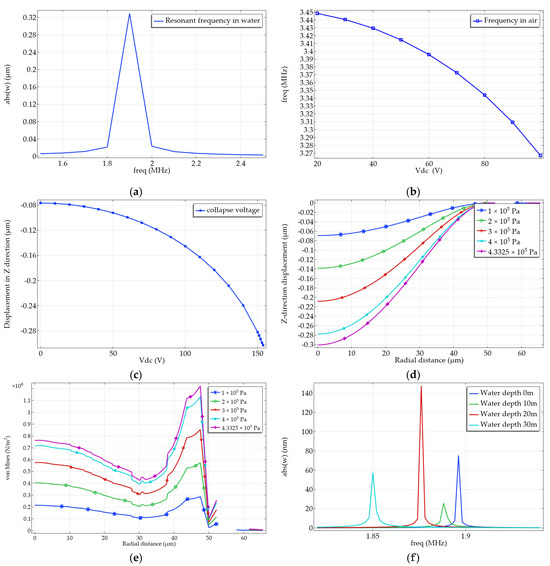
Figure 5.
CMUT performance simulation results: (a) harmonic response; (b) spring softening; (c) collapse voltage; (d) membrane displacement under hydrostatic pressure; (e) diaphragm stress under hydrostatic pressure; (f) resonant frequency at different loads.
Furthermore, as shown in Equations (5) and (6), the collapse voltage significantly influences the sensor’s operating voltage range, and the operating voltage level influences its sensitivity output pressure. Hence, simulating the CMUT collapse voltage is crucial. This voltage is estimated by analyzing the displacement of the lower surface of the membrane’s midpoint towards the bottom of the cavity. Figure 5c demonstrates that the diaphragm moves towards the bottom electrode due to the increasing electric field force as the DC increases. The simulation calculation becomes inaccurate as the membrane collapses when it reaches the bottom of the cavity. The approximate voltage value at which this occurs is referred to as the collapse voltage. However, membrane collapse due to high voltage can lead to electrical breakdown between the top and bottom electrodes, damaging the sensor. In addition, prolonged exposure to high voltage will exacerbate the spring’s softening effect, affecting the sensor’s life and performance. Therefore, one should avoid operating the CMUT in a high-voltage environment for long periods.
For safety reasons, the appropriate water depth is crucial in underwater applications. To simulate water pressure at various depths, pressure is applied to the sensor surface. Figure 5d reveals that 0.3 MPa shifts the membrane midpoint by 208 nm. Simultaneously, Figure 5e illustrates that the maximum stress at the edge of the diaphragm reaches 112 MPa. This stress level is below the safe stress limit of 170 MPa for silicon. Wang R. et al. have stated that the silicon stress should be less than 1/1000 of Young’s modulus [39]. If the pressure on the sensor surface exceeds 0.43 MPa, the diaphragm collapses to the bottom of the cavity. At this point, the maximum stress on the diaphragm is 112 MPa. Consequently, in the conventional operating mode, the maximum depth for use underwater is approximately 30 m. Furthermore, varying loads on the diaphragm’s surface in different water depths exhibit a spring-softening effect similar to the DC bias voltage. COMSOL applied different theoretical loads of varying magnitudes to simulate different water depths. Figure 5f demonstrates that the resonance frequency shifts towards lower frequencies as the diaphragm surface load increases.
4. Manufacturing Process
Research on the CMUT process and its fabrication are crucial to optimizing performance, reliability, and applicability. Continuous innovation and improvement are achievable through a meticulous examination of the relevant process parameters, materials, and fabrication techniques. This approach will facilitate their extensive application in the medical, industrial, and scientific research sectors.
Multiple techniques are available for manufacturing CMUTs, with wafer bonding being a simpler and more consistent approach compared to sacrificial release techniques. However, the Si-Si bonding process is influenced by factors that affect the roughness, cleanliness, and warpage of the bonded wafer surface, as well as control of the bonding parameters. This study utilizes direct Si-Si bonding for effective wafer bonding. The process includes wafer inspection, cleaning, activation treatment, pre-bonding, void detection, and high-temperature annealing.
The process flow of the low-temperature wafer bonding technology developed for CMUT manufacturing is depicted in Figure 6. The process begins with a 4-inch SOI wafer, featuring a 2 µm-thick device layer with a resistivity of less than 0.03 Ω·cm. The silicon wafer has a resistivity of less than 0.003 Ω·cm and a roughness of less than 0.5 nm. Initially, the wafers undergo a cleaning process using acid and alkaline solutions. Subsequently, a 300 nm silica layer is grown on the surface of the silicon wafer by dry-wet-dry oxidation at 1080 °C (Figure 6a). Following this, the bonding surface of the oxide layer is photographed and etched to develop alignment marks and circular depressions (Figure 6b). Dry or wet etching can be utilized to define the cavity structure and alignment marks as the entire oxide layer is etched away. The Si layer functions as a stop layer to ensure cavity height uniformity. The estimated etching rate enables effective control of the cavity’s shape, preventing lateral over-etch on the silicon oxide, which could otherwise increase the cavity size and reduce alignment mark precision.
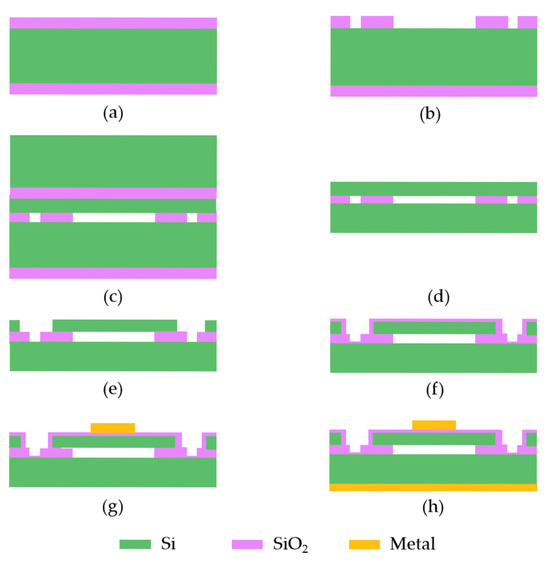
Figure 6.
Si-Si bonding process flow diagram: (a) double-sided oxidation of bulk silicon; (b) RIE etching of cavities and alignment marks; (c) vacuum bonding; (d) CMP thinning + TMAH etching to remove the SOI substrate and BOE to remove the buried oxygen layer; (e) DRIE windowing to expose the alignment marks; (f) PECVD SiO2; (g) magnetron sputtering pattern for the upper electrode; (h) BOE employed to remove silicon oxide and magnetron sputtering to lower electrode.
To ensure the cleanliness of the SOI and Si wafer bonding surfaces, the photoresist on the oxide surface is initially removed by wet cleaning and dry stripping. A newly configured acidic and alkaline solution follows, to remove organic matter and particle contamination from the bonding surface. The cleaned bonded wafer undergoes treatment with O2 gas plasma to generate an intrinsic oxide layer on the silicon wafer through strong oxidation, adsorbing a significant amount of OH groups. Subsequently, the wafers are pre-bonded in a vacuum at 300 °C and 1500 N of pressure, using the EVG510 (Figure 6c). The SOI silicon substrate of the bonded wafer is physically thinned by approximately 200 µm using a CMP (chip multiprocessor) thinning process. The remaining substrate of silicon can be removed by wet etching using a TMAH (tetramethylammonium hydroxide) solution, with the buried oxygen layer acting as an effective stop layer. Alternatively, the SOI substrate layer of the bonded wafer can be etched off using DRIE (deep reactive ion etching) multiple times in the substrate silicon. Following this, the buried oxygen layer is etched using BOE (buffered oxide etching) until the device layer’s surface is completely exposed, forming the CMUT membrane (Figure 6d). Photolithography etching exposes the alignment marks (Figure 6e) to facilitate top electrode patterning.
The top and bottom of the cavity are composed of conductive silicon material, forming a capacitive structure. To prevent membrane movement towards the bottom of the cavity, potentially causing the device to short-circuit (Figure 6f), a specific thickness of SiO2 is applied to the top silicon layer by PECVD (plasma-enhanced chemical vapor deposition). Metal Cr/Au is then deposited on the SiO2 insulating layer using magnetron sputtering. Subsequently, the top electrode, inter-electrode linkage, and Pad lead wire area are patterned (Figure 6g). Similarly, the bottom electrode is formed by sputtering metal onto the back of the silicon (Figure 6h). Finally, the entire wafer undergoes annealing in a vacuum tube annealing furnace, to establish a reliable ohmic contact between the metal and the silicon.
The fabrication utilizes 4-inch low-resistivity silicon wafers, which serve as electrodes for the CMUT without requiring additional doping processes. This approach avoids the internal stress caused by doping and reduces the warpage resulting from high temperatures, simplifying manufacturing. The growth of silicon oxide using the dry-wet-dry oxidation method provides better thickness uniformity and electrical insulation ability compared to low-pressure chemical vapor deposition (LPCVD) technology. In the case of SOI, the buried oxygen layer acts as a stop layer during the removal of its silicon substrate, preserving the integrity of the top layer of silicon as the membrane. The SOI wafer is directly bonded to the silicon wafer through Si-Si bonding at 300 °C under a vacuum environment and 1500 N of pressure, followed by high-temperature vacuum (10−5 mbar) annealing for several hours in an oxidation diffusion furnace. The CMUTs’ cavities are etched onto the oxide layer that has grown on the silicon wafer, whereas the SOI device layer is not patterned (see Figure 6b,c). This technique reduces the accuracy requirements for alignment during bonding. The silicon and SOI surfaces possess good flatness and roughness, enabling easy direct bonding.
5. Testing and Characterization
Testing and characterizing CMUTs are essential steps to evaluate and validate their performance, ensuring reliability and effectiveness. A comprehensive assessment of the mechanical, electrical, and acoustic properties of CMUTs enables the evaluation of performance and the optimization of their design for various applications, including ultrasonic obstacle avoidance, ultrasonic imaging, and non-destructive testing (NDT).
To assess the electrical, vibration, and acoustic performance of the CMUT, tests are conducted to verify the suitability of the manufactured ultrasonic transducer for underwater applications. The wafer is cut into individual CMUT elements. The upper electrode of the CMUT is wire-bonded to the PCB and the wires are then soldered for performance testing.
5.1. Electrical Testing
Firstly, the bare die is checked for its electrical performance. Alloy annealing can be used to improve the performance of the chip if the expected results are not achieved. Testing the electrical performance of an ultrasonic transducer is the first step in verifying its suitability for underwater applications. The CMUTs are subjected to I-V testing, C-V testing, and impedance testing in air using a 4200-SCS semiconductor parameter analyzer (KTE Interactive V9.0), as illustrated in Figure 7. The I-V test result, shown in Figure 7a, exhibits a straight line through the origin, indicating good ohmic contact between the metal and the silicon. The C-V test result, presented in Figure 7b, displays a U-shaped curve, indicating that the chip’s capacitance as the static voltage varies meets the design requirements. An impedance analyzer is used to measure the impedance of the CMUT in air. When a DC bias and a small AC signal are applied between the upper and lower electrodes, resonance peaks appear. The real and imaginary impedance are depicted in Figure 7c,d. The measured impedance matches the circuit parameters in Figure 3.

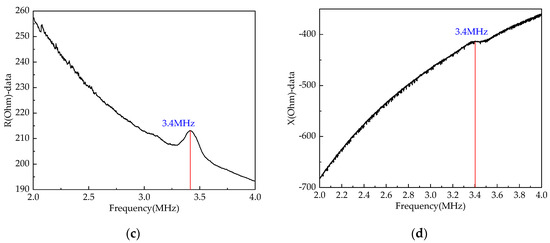
Figure 7.
CMUT test results: (a) I−V test curve; (b) C−V test curve; (c) real part of the impedance curve in air; (d) imaginary part of the impedance curve in air (The red line points to the resonant frequency).
Initially, the bare die undergoes a check for electrical performance. Alloy annealing can be used to enhance chip performance if the expected results are not achieved. Evaluating the electrical performance of an ultrasonic transducer is the primary step in confirming its suitability for underwater applications. The CMUTs are then subjected to I-V testing, C-V testing, and impedance testing in air using a 4200-SCS semiconductor parameter analyzer, as depicted in Figure 7. The I-V test result, shown in Figure 7a, displays a straight line through the origin, indicating good ohmic contact between the metal and the silicon. The C-V test result, presented in Figure 7b, exhibits a U-shaped curve, indicating that the chip’s capacitance varies with static voltage, meeting the design requirements. The impedance analyzer measures the CMUT’s impedance in air, and, when a DC bias and a small AC signal are applied between the upper and lower electrodes, resonance peaks appear. The real and imaginary impedance are depicted in Figure 7c,d. The measured impedance matches the circuit parameters in Figure 3.
5.2. Vibration Testing
The vibration characteristics of the CMUT devices were assessed using a Polytec laser Doppler vibrometer (PSV 9.3.1), as depicted in Figure 8. The results indicate that the CMUT cells exhibit good phase coherence near the first resonance peak. However, this coherence deteriorates as the frequency increases, as illustrated in Figure 9b,c. The impact of the number of cells on the device’s resonant frequency and radiated sound pressure field was determined through theoretical derivation and simulation analysis. The findings reveal that increasing the number of cells leads to a decreased resonant frequency but enhanced radiated sound pressure. To assess the vibration characteristics, the vibration curves of the 12 adjacent cells were tested (as shown in Figure 8) and are presented in Figure 9.
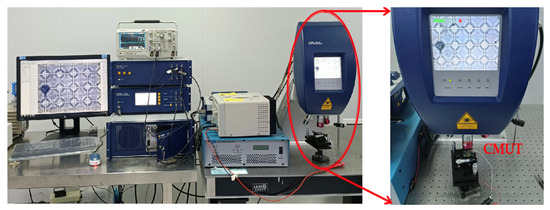
Figure 8.
Polytec laser Doppler vibrometer.
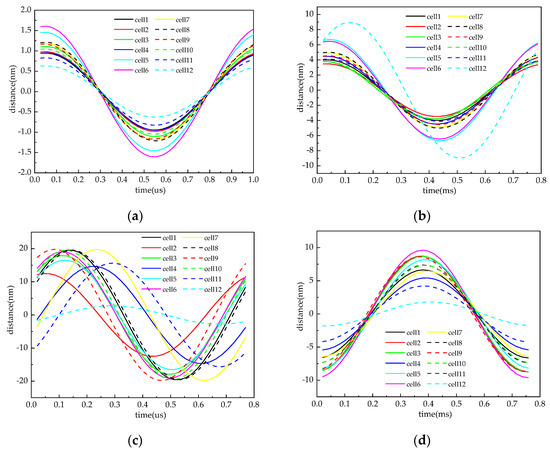
Figure 9.
CMUT micro−element vibration displacement curves at different frequencies: (a) 1.7 MHz; (b) 1.75 MHz; (c) 1.8 MHz; (d) 1.82 MHz.
5.3. Submerged Environment Acoustic Testing and Characterization
When testing CMUTs in water, it is crucial to seal the exposed upper and lower electrodes to prevent CMUT interference or damage. This can be achieved by coating the chip with PDMS (polydimethylsiloxane) to seal and protect it. Immersing the CMUT in silicone oil, a non-conductive substance, allows direct testing. Sufficient sealing is essential to prevent water or moisture from entering the device and affecting its performance.
Qualitative and quantitative tests were conducted to assess the transmitting and receiving capabilities of CMUTs through a piezoelectric transducer during an ultrasonic signal transceiver test. By varying a single variable, the device was immersed in water. The experimental setup for CMUT transmission is shown in Table 2, and the test results are graphed in Figure 10.

Table 2.
CMUT emission performance test experiment.

Figure 10.
CMUT transmit performance test: (a) changing the emission DC bias voltage; (b) changing the AC voltage; (c) changing the receiving distance.
When the CMUT is used as a transmitter, a DC bias voltage is applied to generate electrostatic force (Fe). An ultrasonic signal is generated under AC. The acoustic pressure can be expressed as the product of the vibrational velocity u of the CMUT vibrating membrane and its radiation resistance Rr. The radiation resistance depends on the density ρ0 of the medium and the radius a of the transmitting array element, as shown in Equation (7). The vibrational velocity of the CMUT can be determined using Equation (8).
The vibration velocity is directly proportional to the uniform external pressure P applied on the film, primarily due to the electrostatic force Fe and the elastic restoring force Fs, which are expressed by Equations (9) and (10). The emitted sound pressure Pout can be calculated using Equation (11).
Consequently, the emitted sound pressure and AC signal exhibit quadratic behavior, as depicted in Figure 10b. Nonlinearity is observable in the DC bias voltage and the emitted sound pressure is due to the shift in resonant frequency towards lower frequencies with an increase in voltage. Ultrasound experiences attenuation through diffusion, absorption, and scattering in the aqueous medium. As the distance between the transmitter and receiver increases, the signal attenuation linearly increases, resulting in a constant weakening of the signal intensity, as illustrated in Figure 10c.
The reception performance of the CMUT was tested using a piezoelectric sensor for transmission and the CMUT for reception. Details of the experimental setup are given in Table 3 and the results of the experiment are shown in Figure 11.

Table 3.
CMUT reception performance test experiment.

Figure 11.
CMUT reception performance test: (a) changing the transmission of AC; (b) changing the receiving DC bias voltage; (c) changing the receiving distance.
When acting as a receiver, the CMUT is affected by two forces: the electrostatic force Fe generated by the VDC, which compels the membrane to undergo pre-deformation, and the external force Fu. This force leads to a change in the distance between the upper and lower electrodes, resulting in a variation in the capacitance value between the electrodes. Consequently, a current that varies with the capacitance value is generated, as indicated in Equation (12). The current is then amplified by trans-resistance and converted into a voltage value.
The initial height of the cavity, denoted as g0, and the displacement of the film, denoted as w1, determine the received signal, which is linearly proportional to the VDC, as depicted in Figure 11b.
The critical distance Zg refers to the distance from the sound source of the piston, where a transition from the near field to the far field occurs. This distance can be calculated using Equation (12). At this location and in the near-field region, the sound pressure amplitude is exceptionally high. The ultrasonic waves display undulating characteristics in their sound pressure amplitude due to the radiation emitted by the piston. As the ultrasonic waves propagate, they experience gradual attenuation, causing the ultrasonic intensity to weaken with the increasing distance.
The radius of the piston (element) is denoted by a and the wavelength is represented by λ. The critical distance, which distinguishes the far field from the near field, can be calculated theoretically using Equation (13), taking into account the values of a and λ. The calculated theoretical value of the critical distance is 9.8 cm. In Figure 11c, the measured result is shown to be 10 cm, establishing agreement between the measured and theoretical values.
5.4. CMUT Receiver Response
The receiving sensitivity of the CMUT refers to its ability to detect and convert acoustic signals into electrical signals when functioning as a receiver. It denotes the efficiency and sensitivity of the CMUT in converting acoustic pressure signals into electrical signals while receiving acoustic waves. Figure 12 illustrates the setup used to measure the receiving sensitivity, comprising a PZT (HPCTN-3-10-I-A), manufactured by the 715 Research Institute of China Shipbuilding Industry Corporation (CSIC), as a transmitter, a needle hydrophone (PA4000), and a CMUT as the ultrasound receiver. The emission sound source level of the PZT and the received frequency response of the needle hydrophone are depicted in Table 4 and Table 5. During the test, the transmitter signal comprised five cycles, with frequencies ranging from 500 kHz to 4000 kHz. The acoustic signal emitted by the PZT was initially captured by a needle hydrophone, and the sound pressure was calculated based on the amplitude of the received signal. The needle hydrophone was then replaced by a CMUT at the same position in the receiver. Throughout the frequency sweep, the received voltage was recorded, and the received frequency response of the CMUT was subsequently calculated. Figure 13 presents the results of the CMUT received sensitivity test at varying frequencies, indicating a −3 dB bandwidth of 108.7%.

Figure 12.
The receiving voltage response experimental test system.

Table 4.
PZT standard emission source level.

Table 5.
Needle hydrophone standard signal source level.
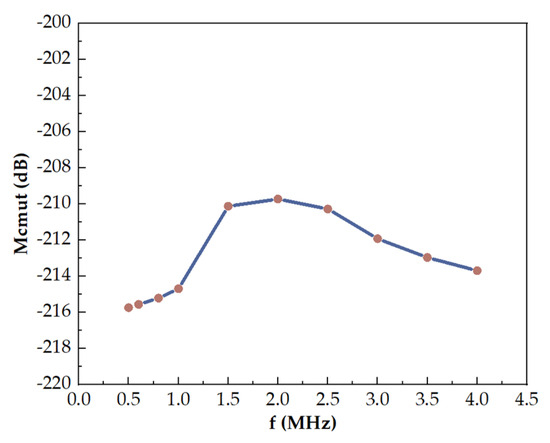
Figure 13.
Reception sensitivity test curve.
5.5. CMUT Transmission Response
The transmit voltage response of the CMUT refers to its response in transmission mode when excited by an electrical signal, leading to the generation of an acoustic field at a distance of L in the pointing direction. It characterizes the transducer’s ability to emit signals and provides information about the amplitude and frequency characteristics of the transmitted signal. The test platform for measuring the emission response is depicted in Figure 14. In this test system, the CMUT being examined acts as the transmitter, while a needle hydrophone positioned 20 cm in front of it serves as the receiver. Throughout the test, the transmitter emits five cycles of signals, with frequencies ranging from 500 kHz to 4000 kHz. The signal amplitude of the receiver is utilized to calculate the transmission response of the CMUT. The emission reaches a maximum of 145.05 dB at 2 MHz. The test results are presented in Figure 15.
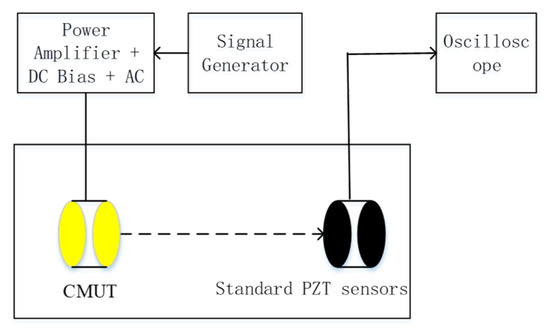
Figure 14.
Emission voltage response experimental test system.
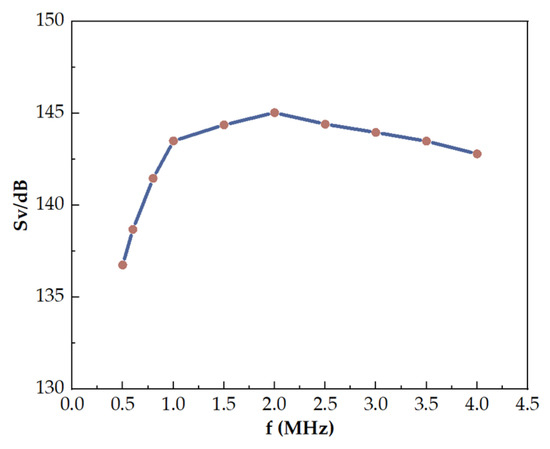
Figure 15.
Emission response test curve.
5.6. Underwater Directivity Experiment
Directivity, which refers to the ability of a sensor to transmit and receive ultrasound in a specific direction, plays a crucial role in CMUT applications for underwater obstacle avoidance. It enhances target detection and localization accuracy, obstacle detection and classification, and distance measurement. To evaluate the emission directivity of the CMUT, a test environment was set up, as shown in Figure 16. The setup includes a rotatable device attached to a cylindrical cylinder, with a precision indexing turntable mounted beneath the encapsulated end of the CMUT. The excitation signal had a frequency of 2 MHz, an amplitude of 20 Vpp, and consisted of five continuous sinusoidal pulses with a DC bias of 30 V. The sound field was perpendicular to the cylinder wall. A standard power transducer was positioned at a fixed distance of 20 cm from the transmitter, at the same height as the center of the CMUT. The test involved rotating the system in 1° increments, with the receiver at the center, covering a 30° rotation on each side. This allowed a comprehensive evaluation of the CMUT’s emission directivity. Figure 17 illustrates the results of this test. Additionally, the same procedure was followed to assess the receiver’s directivity, replacing the CMUT with a calibrated piezoelectric transducer to act as the transmitter and positioning the CMUT at the hydrophone’s location to act as the receiver. The receiver directivity results are also displayed in Figure 17. The CMUT used in these tests demonstrated a primary flap width of 7.3° at −6 dB, indicating its ability to accurately determine and locate obstacles. Placing multiple CMUT elements in the front of a fish−shaped robot can provide accurate forward positioning, expanding the field of view for obstacle avoidance.
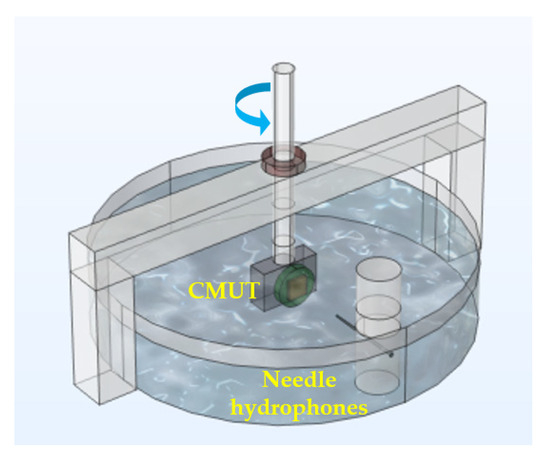
Figure 16.
Schematic diagram of the directional testing device.
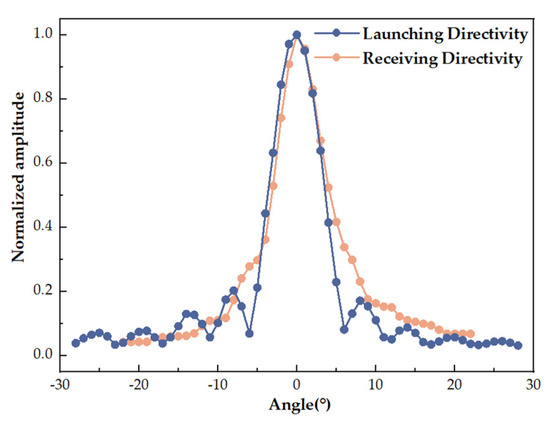
Figure 17.
The results of the directional testing.
5.7. Underwater Reflection Experiment
Underwater obstacle avoidance involves emitting high-energy ultrasound through an ultrasonic detector. After receiving the reflected waveform, the distance and direction of the target can be calculated. The system can determine whether to initiate obstacle avoidance actions, such as moving forward or backward, by comparing the measured value with a pre-defined threshold. An experimental test platform, illustrated in Figure 18a, was used to verify the feasibility of using the CMUT in obstacle avoidance. In this test, an aluminum block served as an obstacle. The CMUT was employed to transmit ultrasonic signals and receive the waves reflected from the aluminum block. A computer console emitted a 10-cycle sinusoidal pulse signal with a DC bias of 30 V and an AC signal of 10 Vpp. The test involved measuring the reflected signals at distances from 22 cm to 42 cm in 4 cm increments. The received signals were then amplified by 40 dB, as depicted in Figure 18c. Additionally, the discrepancy between the tested distance and the actual distance was analyzed. Error bars were determined by analyzing the reflection data from the aluminum plate at various distances of the ultrasonic sensor. The mean value was used as the central tendency metric, while the standard deviation was employed. The obtained results demonstrated a standard deviation of less than 0.05 at various test distances, as depicted in Figure 18d. Furthermore, sand and ink were added to the water to simulate turbid water, as shown in Figure 18b. The reflected signals in clear and turbid water were compared at a distance of 30 cm, as displayed in Figure 18e. The presence of sand particles led to signal scattering and an increase in the speed of propagation. Consequently, the reflected signal in turbid water exhibited an ahead phase of about 0.27 µs compared to the signal in clear water, accompanied by an amplitude reduction of about 23.36 mV. These findings indicate the feasibility of CMUTs for use in obstacle avoidance in turbid water.
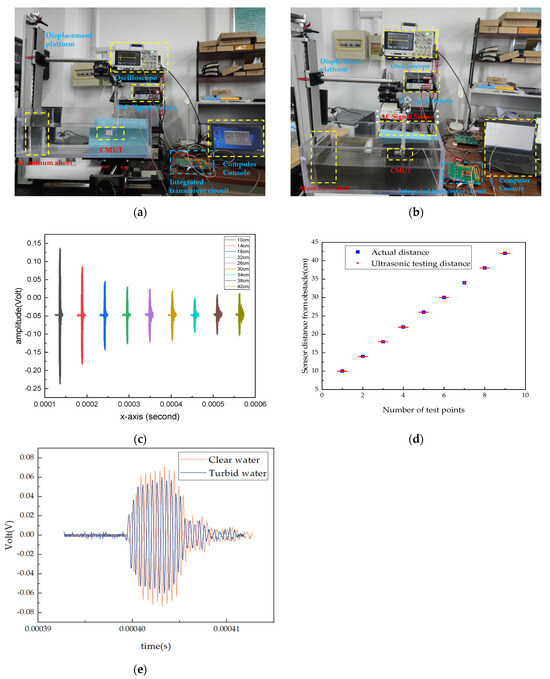
Figure 18.
Reflected signals at different distances in water: (a) clear water reflection experimental test platform; (b) turbid water reflection experimental test platform; (c) reflected signals at different distances; (d) test distance error bars; (e) reflected signal in clear water compared to turbid water.
6. Discussion and Conclusions
This study utilized COMSOL to model the CMUT, simulating its resonant frequency, collapse voltage, and other properties in water. The CMUT elements for underwater applications were designed and fabricated using a silicon-silicon bonding process. MEMS technology facilitated low-cost mass production, ensuring precise control over the dimensional uniformity of the structure. The feasibility of the process preparation has been verified by electrical tests and vibration tests in an experimental environment. Acoustic testing of the CMUT in water, following waterproof assembly with PDMS, verified the miniaturization (1 mm × 1.2 mm), wide bandwidth (108.7% at −3 dB), and highly directional (7.3° at −6 dB) performance of the CMUT and the feasibility of underwater ultrasonic signal transmission and reception. The miniature robotic fish moves slowly within confined spaces, and the 40 cm+ reflex test ensures its ability to react to and avoid obstacles. The test for receiving reflective signals in turbid water enables the fish to operate in conditions of low light and turbidity. This demonstrates the feasibility of applying CMUTs to underwater micro-obstacle avoidance robots.
This study compares CMUTs with other existing piezoelectric transducers, as presented in Table 6. The bandwidth of the CMUT is significantly higher than that of the piezoelectric transducer. Although the emitted sound pressure represents a slight disadvantage due to the small area, the emission sound pressure per unit area is maximized. Simultaneously, the advantage of integration with the CMOS allows for a very small package volume. This positions the CMUT as a viable option for underwater miniature robot fish. The specific implementation of obstacle avoidance also necessitates multi-sensor data fusion processing to regulate the subsequent behavior of the robotic fish. Currently, we have completed the preparation and validation of the sensor design. The reception of the underwater transmission signal and the reflection signal in turbid water confirms the feasibility of using CMUTs for implementing obstacle avoidance in underwater micro-robots. Practical tests will be conducted in conjunction with processing algorithms and control programs.

Table 6.
CMUT vs. piezoelectric transducer.
Additionally, CMUTs offer the advantages of being miniaturized, arrayable, and easily integrated with circuits, showcasing their potential to further reduce the size of underwater micro-robots. The CMUT preparation process is relatively simple and is easily implemented in an experimental environment, with high consistency of the produced CMUTs. The specific implementation of obstacle avoidance also necessitates multi-sensor data fusion processing to regulate the subsequent behavior of the robotic fish. Currently, we have completed the preparation and validation of the sensor design. The reception of the underwater transmission signal and the reflection signal in turbid water confirms the feasibility of the CMUT for implementing obstacle avoidance in underwater micro-robots. Practical tests will be conducted in conjunction with processing algorithms and control programs. In future work, line and surface arrays will be designed and prepared for application with underwater micro-robotic fish, enabling obstacle imaging. Furthermore, exploring acoustic impedance matching layers and more robust encapsulation materials enhances the potential of CMUTs for marine applications. As science advances and new materials are discovered and applied, advancements in underwater measurement and detection technologies are inevitable. The ongoing progress seen in MEMS technology has established CMUT underwater ultrasound as a practical choice for water-quality testing, underwater communications, underwater navigation, and even marine applications.
Author Contributions
Conceptualization, Z.W., S.L. and R.W.; methodology, Z.W., J.W. and Y.Q.; software, C.H. and X.L.; validation, Z.W., S.L. and J.W.; formal analysis, Z.W. and Z.L.; investigation, Z.W. and R.W.; resources, C.H. and W.Z.; data curation, Z.W., S.L. and J.W.; writing—original draft preparation, Z.W.; writing—review and editing, Z.W. and Y.Q.; visualization, Z.W. and R.W.; supervision, G.Z. and W.Z.; project administration, Y.Y., J.C. and L.J.; funding acquisition, W.Z. All authors have read and agreed to the published version of the manuscript.
Funding
This research was funded by the National Natural Science Foundation of China (grants 61927807, 52275578), the National Key Research and Development Program (2020YFC0122102), the Fundamental Research Program of Shanxi Province (20210302123027, 20210302124203) and the Shanxi “1331 Project” Key Subject Construction (1331KSC).
Data Availability Statement
Data are contained within the article.
Conflicts of Interest
The authors declare no conflicts of interest.
References
- Braginsky, B.; Guterman, H. Obstacle Avoidance Approaches for Autonomous Underwater Vehicle: Simulation and Experimental Results. IEEE J. Ocean. Eng. 2016, 41, 882–892. [Google Scholar] [CrossRef]
- Lin, C.; Wang, H.; Yuan, J.; Yu, D.; Li, C. An improved recurrent neural network for unmanned underwater vehicle online obstacle avoidance. Ocean. Eng. 2019, 189, 106327. [Google Scholar] [CrossRef]
- Cao, X.; Ren, L.; Sun, C. Research on Obstacle Detection and Avoidance of Autonomous Underwater Vehicle Based on Forward-Looking Sonar. IEEE Trans. Neural Netw. Learn. Syst. 2022, 34, 9198–9208. [Google Scholar] [CrossRef] [PubMed]
- Li, C.; Guo, S.; Guo, J. Study on Obstacle Avoidance Strategy Using Multiple Ultrasonic Sensors for Spherical Underwater Robots. IEEE Sens. J. 2022, 22, 24458–24470. [Google Scholar] [CrossRef]
- Lu, M.; Chen, H.; Lu, P. Perception and Avoidance of Multiple Small Fast Moving Objects for Quadrotors with Only Low-Cost RGBD Camera. IEEE Robot. Autom. Lett. 2022, 7, 11657–11664. [Google Scholar] [CrossRef]
- Badrloo, S.; Varshosaz, M.; Pirasteh, S.; Li, J. A novel region-based expansion rate obstacle detection method for MAVs using a fisheye camera. Int. J. Appl. Earth Obs. Geoinf. 2022, 108, 102739. [Google Scholar] [CrossRef]
- Li, Y.; Ibanez-Guzman, J. Lidar for Autonomous Driving: The Principles, Challenges, and Trends for Automotive Lidar and Perception Systems. IEEE Signal Process. Mag. 2020, 37, 50–61. [Google Scholar] [CrossRef]
- Mandischer, N.; Eddine, S.C.; Huesing, M.; Corves, B. Radar SLAM for Autonomous Indoor Grinding. In Proceedings of the 2020 IEEE Radar Conference (RadarConf20), Florence, Italy, 21–25 September 2020; pp. 1–6. [Google Scholar]
- Khan, M.U.; Zaidi, S.A.A.; Ishtiaq, A.; Bukhari, S.U.R.; Samer, S.; Farman, A. A Comparative Survey of LiDAR-SLAM and LiDAR based Sensor Technologies. In Proceedings of the 2021 Mohammad Ali Jinnah University International Conference on Computing (MAJICC), Karachi, Pakistan, 15–17 July 2021; pp. 1–8. [Google Scholar]
- Adelegan, O.J.; Coutant, Z.A.; Wu, X.; Yamaner, F.Y.; Oralkan, Ö. Design and Fabrication of Wideband Air-Coupled Capacitive Micromachined Ultrasonic Transducers with Varying Width Annular-Ring and Spiral Cell Structures. IEEE Trans. Ultrason. Ferroelectr. Freq. Control 2021, 68, 2749–2759. [Google Scholar] [CrossRef]
- Wang, Z.; He, C.; Zhang, W.; Li, Y.; Gao, P.; Meng, Y.; Zhang, G.; Yang, Y.; Wang, R.; Cui, J.; et al. Fabrication of 2-D Capacitive Micromachined Ultrasonic Transducer (CMUT) Array through Silicon Wafer Bonding. Micromachines 2022, 13, 99. [Google Scholar] [CrossRef]
- Tong, Z.; Wu, Z.; Zhang, S.; Liu, H.; Lou, L. A Flexible Ultrasonic Sensor Based on Piezoelectric Micromachined Ultrasonic Transducers (pMUTs). In Proceedings of the 2021 22nd International Conference on Electronic Packaging Technology (ICEPT), Xiamen, China, 14–17 September 2021; pp. 1–4. [Google Scholar]
- Sadeghpour, S.; Kraft, M.; Puers, R. Design and fabrication strategy for an efficient lead zirconate titanate based piezoelectric micromachined ultrasound transducer. J. Micromechanics Microengineering 2019, 29, 125002. [Google Scholar] [CrossRef]
- Feng, G.H.; Liu, H.J.; Lai, G.R. Piezoelectric Micromachined Ultrasonic Transducer with a Universal Bottom-Up Fabrication Approach Implemented on a Foil as Doppler Radar for Gesture Recognition. In Proceedings of the 2019 IEEE 32nd International Conference on Micro Electro Mechanical Systems (MEMS), Seoul, Republic of Korea, 27–31 January 2019; pp. 779–782. [Google Scholar]
- Malik, A.N.; Rowland, J.; Haber, B.D.; Thom, S.; Jackson, B.; Volk, B.; Ehrman, R.R. The Use of Handheld Ultrasound Devices in Emergency Medicine. Curr. Emerg. Hosp. Med. Rep. 2021, 9, 73–81. [Google Scholar] [CrossRef] [PubMed]
- Haller, M.I.; Khuri-Yakub, B.T. A surface micromachined electrostatic ultrasonic air transducer. In Proceedings of the 1994 IEEE Ultrasonics Symposium, Cannes, France, 31 October–3 November 1994; Volume 1242, pp. 1241–1244. [Google Scholar]
- Soh, H.T.; Ladabaum, I.; Atalar, A.; Quate, C.F.; Khuri-Yakub, B.T. Silicon micromachined ultrasonic immersion transducers. Appl. Phys. Lett. 1996, 69, 3674–3676. [Google Scholar] [CrossRef]
- Huang, Y.; Ergun, A.S.; Haeggstrom, E.; Khuri-Yakub, B.T. Fabrication of Capacitive Micromachined Ultrasonic Transducers (CMUTs) using wafer bonding technology for low frequency (10 kHz–150 kHz) sonar applications. In Proceedings of the OCEANS’02 MTS/IEEE, Biloxi, MI, USA, 29–31 October 2002; Volume 2324, pp. 2322–2327. [Google Scholar]
- Park, K.K.; Lee, H.; Kupnik, M.; Khuri-Yakub, B.T. Fabrication of Capacitive Micromachined Ultrasonic Transducers via Local Oxidation and Direct Wafer Bonding. J. Microelectromechanic. Syst. 2011, 20, 95–103. [Google Scholar] [CrossRef]
- Yamaner, F.Y.; Zhang, X.; Oralkan, Ö. A three-mask process for fabricating vacuum-sealed capacitive micromachined ultrasonic transducers using anodic bonding. IEEE Trans. Ultrason. Ferroelectr. Freq. Control 2015, 62, 972–982. [Google Scholar] [CrossRef]
- Moini, A.; Nikoozadeh, A.; Choe, J.W.; Chang, C.; Stephens, D.N.; Sahn, D.J.; Khuri-Yakub, P.T. Fully integrated 2D CMUT ring arrays for endoscopic ultrasound. In Proceedings of the 2016 IEEE International Ultrasonics Symposium (IUS), Tours, France, 18–21 September 2016; pp. 1–4. [Google Scholar]
- Pang, D.-C.; Chang, C.-M. Development of a Novel Transparent Flexible Capacitive Micromachined Ultrasonic Transducer. Sensors 2017, 17, 1443. [Google Scholar] [CrossRef]
- Park, K.K.; Kupnik, M.; Lee, H.J.; Khuri-Yakub, B.T.; Wygant, I.O. Modeling and measuring the effects of mutual impedance on multi-cell CMUT configurations. In Proceedings of the 2010 IEEE International Ultrasonics Symposium, San Diego, CA, USA, 11–14 October 2010; pp. 431–434. [Google Scholar]
- Hsu, T.H.; Zope, A.A.; Li, M.H.; Li, S.S. A Compact Monolithic CMUT Receiver Front-End in a TiN-C CMOS-MEMS Platform. In Proceedings of the 2020 IEEE International Ultrasonics Symposium (IUS), Las Vegas, NV, USA, 7–11 September 2020; pp. 1–4. [Google Scholar]
- Danhua, Z.; Zhuang, S.; Daigle, R. A commercialized high frequency CMUT probe for medical ultrasound imaging. In Proceedings of the 2015 IEEE International Ultrasonics Symposium (IUS), Taiwan, China, 21–24 October 2015; pp. 1–4. [Google Scholar]
- Rezvanitabar, A.; Kilinc, M.S.; Tekes, C.; Arkan, E.F.; Ghovanloo, M.; Degertekin, F.L. An Adaptive Element-Level Impedance-Matched ASIC with Improved Acoustic Reflectivity for Medical Ultrasound Imaging. IEEE Trans. Biomed. Circuits Syst. 2022, 16, 492–501. [Google Scholar] [CrossRef]
- Yoon, H.S.; Chang, C.; Jang, J.H.; Bhuyan, A.; Choe, J.W.; Nikoozadeh, A.; Watkins, R.D.; Stephens, D.N.; Pauly, K.B.; Khuri-Yakub, B.T. Ex Vivo HIFU Experiments Using a 32 × 32-Element CMUT Array. IEEE Trans. Ultrason. Ferroelectr. Freq. Control 2016, 63, 2150–2158. [Google Scholar] [CrossRef]
- Pelenis, D.; Barauskas, D.; Vanagas, G.; Dzikaras, M.; Ultrasonics, D.V.J. CMUT-based biosensor with convolutional neural network signal processing. Ultrasonics 2019, 99, 105956. [Google Scholar] [CrossRef]
- Choi, W.Y.; Kwak, Y.S.; Park, K.K. Fingerprint Imaging System Based on Capacitive Micromachined Ultrasonic Transducer by Using Impediography Method Including Direct Touch and Waveguide Methods. IEEE Trans. Ultrason. Ferroelectr. Freq. Control 2019, 66, 402–411. [Google Scholar] [CrossRef]
- Anzinger, S.; Bretthauer, C.; Wasisto, H.S.; Dehé, A. Dual-Backplate CMUTs with Wide Bandwidth and Low Driving Voltage for Airborne Applications. IEEE Trans. Ultrason. Ferroelectr. Freq. Control 2023, 70, 1286–1294. [Google Scholar] [CrossRef]
- Wygant, I.O.; Kupnik, M.; Khuri-Yakub, B.T. Analytically calculating membrane displacement and the equivalent circuit model of a circular CMUT cell. In Proceedings of the 2008 IEEE Ultrasonics Symposium, Beijing, China, 2–5 November 2008; pp. 2111–2114. [Google Scholar]
- Auerswald, C.; Sorger, A.; Dienel, M.; Shaporin, A.; Mehner, J. MEMS acoustic emission sensor with mechanical noise rejection. In Proceedings of the International Multi-Conference on Systems, Signals & Devices, Chemnitz, Germany, 20–23 March 2012; pp. 1–6. [Google Scholar]
- Brenner, K.; Ergun, A.S.; Firouzi, K.; Rasmussen, M.F.; Stedman, Q.; Khuri-Yakub, B. Advances in Capacitive Micromachined Ultrasonic Transducers. Micromachines 2019, 10, 152. [Google Scholar] [CrossRef] [PubMed]
- Savoia, A.S.; Scaglione, G.; Haider, B. Combined use of Finite Element and Equivalent Circuit Modeling for System-Level Simulation of Integrated Capacitive Micromachined Ultrasonic Transducers (CMUT). In Proceedings of the 2020 IEEE International Ultrasonics Symposium (IUS), Las Vegas, NV, USA, 7–11 September 2020; pp. 1–4. [Google Scholar]
- Zhao, Y.; Zhao, L.; Barbruni, G.L.; Li, Z.; Jiang, Z.; Carrara, S. Equivalent Circuit Analysis of CMUTs-based Device for Measurement in Liquid Samples. In Proceedings of the 2021 IEEE International Symposium on Medical Measurements and Applications (MeMeA), Lausanne, Switzerland, 23–25 June 2021; pp. 1–5. [Google Scholar]
- Wang, H.; Ma, Y.; Yang, H.; Jiang, H.; Ding, Y.; Xie, H. MEMS Ultrasound Transducers for Endoscopic Photoacoustic Imaging Applications. Micromachines 2020, 11, 928. [Google Scholar] [CrossRef] [PubMed]
- Ray, A.; Sinha, S.; Haque, F.Z. Design of CMUT Cells for High-Intensity Focused Ultrasound Applications. In Proceedings of the 2022 IEEE International Conference of Electron Devices Society Kolkata Chapter (EDKCON), Kolkata, India, 26–27 November 2022; pp. 145–150. [Google Scholar]
- Bannon, F.D.; Clark, J.R.; Nguyen, C.T.C. High-Q HF microelectromechanical filters. IEEE J. Solid State Circuits 2000, 35, 512–526. [Google Scholar] [CrossRef]
- Wang, R.; Shen, W.; Zhang, W.; Song, J.; Li, N.; Liu, M.; Zhang, G.; Xue, C.; Zhang, W. Design and implementation of a jellyfish otolith-inspired MEMS vector hydrophone for low-frequency detection. Microsyst. Nanoeng. 2021, 7, 1. [Google Scholar] [CrossRef] [PubMed]
- Shim, H.; Roh, Y. Design and Fabrication of a Wideband Cymbal Transducer for Underwater Sensor Networks. Sensors 2019, 19, 4659. [Google Scholar] [CrossRef]
- Abdullah, Z.; Naz, S.; Raja, M.A.Z.; Zameer, A. Design of wideband tonpilz transducers for underwater SONAR applications with finite element model. Appl. Acoust. 2021, 183, 108293. [Google Scholar] [CrossRef]
- Xia, L.; Wang, H.; Huang, Q. Design and Fabrication of a Stacked Three-Phase Piezoelectric Composites Ring Array Underwater Ultrasound Transducer. Materials 2021, 14, 5971. [Google Scholar] [CrossRef]
Disclaimer/Publisher’s Note: The statements, opinions and data contained in all publications are solely those of the individual author(s) and contributor(s) and not of MDPI and/or the editor(s). MDPI and/or the editor(s) disclaim responsibility for any injury to people or property resulting from any ideas, methods, instructions or products referred to in the content. |
© 2024 by the authors. Licensee MDPI, Basel, Switzerland. This article is an open access article distributed under the terms and conditions of the Creative Commons Attribution (CC BY) license (https://creativecommons.org/licenses/by/4.0/).